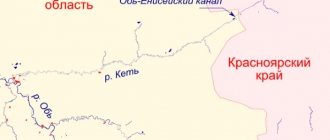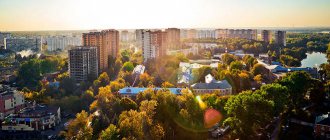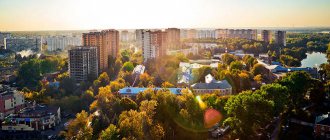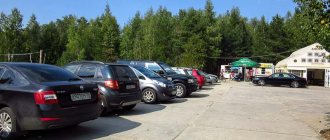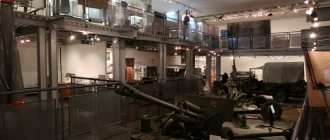It is generally accepted that Soviet architecture is monotonous and boring. This is especially true about the residential areas of the late USSR, with their poor planning and landscaping, shabby walls and poor entrances.
But Soviet architecture is different. Where the project was influenced not only by foremen, but also by architects, there are interesting solutions. For example, in the city of Protvino - a science city a hundred kilometers south of Moscow, which literally stands in the middle of a forest. Now its residents are trying to save their historical heritage from poor amenities and a “comfortable urban environment.”
City in the forest
In the early 1960s, the USSR decided to build the U-70 proton accelerator, the largest in the world at the time of its launch. They were looking for a place for it in the Moscow region. We stopped at the Protva River, from which the city got its name. The Institute of High Energy Physics was built here, whose employees worked with the accelerator. In the 1980s, they began to build a domestic hadron collider nearby, but due to lack of money it was mothballed.
Photo: trowel.zhzh.rf
Together with the institute, they began to build a city, right in the forest. The country has already adopted a resolution “on excesses”; deadlines and builders, rather than quality and architects, have become king. But at the same time, the concept of academic towns was emerging: unable to influence the shape of buildings, architects began to work more closely with landscaping and landscaping, and forests began to be purposefully introduced into their environment.
General plan of the city
The architects devoted all their efforts to preserving it. For example, the height and location of the buildings made it possible to build without cranes, and materials were supplied from the ends - as a result, in the courtyards of ordinary Khrushchev-era buildings there are trees that are older than the city itself. The yard-forest is not a marketing slogan here, but ordinary realities.
For the safety of residents, a kilometer-long forest zone was created between the institute and residential buildings. Since scientists worked with proton radiation, such a buffer was supposed to protect people from possible harm to health.
Everything once happened for the first time (the story of Protvino, part II)
The first high-rise buildings in Protvino - st. Pobeda-3, 5, 7, Lenina-3, Molodezhny Ave.-3
The Protvinsk news agency continues publications dedicated to the history of our city. All information and photographic materials were provided by the head of the local history department of the city library, Nadezhda Bakatura.
First teachers
The first primary classes for 30 students were opened in September 1960 in two rooms of the barracks. The teachers of these classes were Zoya Nikolaevna and Evgeniy Sergeevich Barancheev. The first new school was put into operation in two stages: in 1962, the primary school building was put into operation, and the entire complex was put into operation by September 1, 1963. It was a modern building for a thousand students with a sports hall and an assembly hall. The first director of the school was Ivan Petrovich Aksenov, the head teacher was Inna Vasilievna Trushko. From 1964 to 1971, the school was headed by Mikhail Vasilyevich Nesmelov, an honored teacher of the RSFSR, and since 2000, an honorary citizen of the city of Protvino, who worked in the field of education for more than 30 years and headed first school No. 1, and then the new building school No. 2.
Trade and catering have always been at their best
The buildings of the House for the Invalids No. 12 of the Moscow City Department of Social Security, built in 1954, were in great demand by builders - in 1960 they housed a kindergarten, a canteen, a club and a store.
ORS (work supply department) began to be organized in 1960 as a branch of the Moskvoretsky ORS of the Ministry of Medium Machine Building. For these purposes, existing canteen and store buildings in the stadium area were used. The head of the canteen was Nadezhda Vasilievna Stakhanova, the buffet was in charge of Galina Alekseevna Gorlova, and Alexandra Gavrilovna Kulagina was the head of the store. The first head of ORS was Sergei Petrovich Suchkov, then he was headed at different times by: A.A. Borisov, E.M. Golikov, V.G. Lobov, V.A Shabrov. Trade and catering in the city have always been at their best. The management of ORS paid great attention to training, education and selection of personnel.
Urban energy
On December 12, 1963, the Department of the Chief Power Engineer was created at IHEP.
The energy of the newborn city developed rapidly. By the end of 1963 the following were already working:
· boiler room of a residential village (at the intersection of Mira and Shkolnaya streets);
· electrical substation RP-50;
·first stage of treatment facilities;
·the first stage of the Kaluga water intake with a capacity of 5,000 cubic meters of artesian water per day;
· many kilometers of engineering networks, without which this entire economy cannot function.
Around the same time, the construction of the boiler house technical site at IHEP was completed. Hot water and heat from it began to flow by March 8, 1964. The first consumers were the objects of the rapidly developing Institute and the residents of Protvino (several residential buildings on Mira Street, school No. 1, wooden barracks of the “lower” Protvino, where the club, canteen, administration building and others were located). There were no industrial enterprises then.
Forest dance floor
“From Pobeda Street in the old part of the city there is a park beloved by three generations of citizens in a relict pine forest with concrete paths and the famous beautiful dance floor of the 80s under centuries-old pine trees, where Mosfilm, which chose this fabulous place, shot dozens of films,” - so about this place written in materials stored in our library.
Currently, there has been no music on this dance floor for a long time, bushes are growing through the marble slabs of the covering, the walls are painted indecently and artlessly by hooligans... Well, due to the active development of the microdistrict, it seems that the next generations may not see this object there anymore.
However, this is the first dance floor in Protvino. It appeared around 1975–1977. This was precisely the time when dance verandas were built everywhere. It was designed at GSPI under the leadership of architect N.D. Lisitsyn.
Physicists' Cafe
In 1965, the first Protvinsk cafe “Orbita” opened on Pobeda Street. In the magazine “Science and Life” (No. 3, 1971) they wrote about him: “On the wall of the cafe there is a node of electronic orbits. This symbol is very appropriate on this wall. Firstly, because it is a literal translation of the name of the cafe into the language of the drawing. The cafe is called "Orbita". Secondly, because this cafe is a physicists’ cafe. It is located in the city of physicists, Protvino.”
A square where flowers grew
In 1968, master V.A. Nikolenko together with foreman A.I. Petrakov, the future Minister of Construction of the Moscow Region, designed a park on Pobeda Street, where flower beds, benches and small architectural forms, pools and ponds with mosaics and fish were erected. People called it “a square in pants”; in honor of the 30th anniversary of Russian-French cooperation, it was named “Mirabelle”.
First fountain
It was built in the city in the 70–80s on the square near the recreation center (square).
On June 12, 2007 - on Russia Day - a new fountain was opened on the square in front of the Proton cultural center. A musical and water structure with beautiful lighting, built with funds from a number of enterprises and private entrepreneurs of the city on the site of a fountain that functioned in the 70s and 80s, was named “Tenderness”. The source of natural coolness has become a favorite vacation spot for residents and guests of the city, especially young people.
JUST THE FACTS
1962 services , a post office, and the “Serpukhov - Protvino” bus appeared (people used the expressions about it “to travel in its own juice”, “a bus as rare as happiness”).
January 2, 1963 – the bathhouse opened.
July 1, 1965 – the first bookstore “Knowledge” opened on the street. Victory-6. Director – Lyubov Dmitrievna Kairova.
1968 – the first run “Protvino – Serpukhov”, organized by A.N. Golovanov.
October 14, 1988 – the first issue of the large-circulation IHEP newspaper “Accelerator”. The first editor is Evgeny Mashkov.
Source:
https://inprotvino.ru/novosti/gorod/vse_kogdato_bylo_vpervye_istoriya_protvino_chast_ii_730824
Architecture
The main role in the city is played by the Institute of High Energy Physics, surrounded by barbed wire. The theoretical building of the institute hosted scientists from all over the world, so the architects tried to emphasize the role of this building as a dominant feature in the city.
Plaster shining in the sun is a characteristic coating for the facades of public buildings in Protvino. This is a mixture of ordinary plaster with granite chips, which shines beautifully in the sun and emphasizes the shape of the facade.
Monumental artists actively participated in the design of city buildings. They lived and worked here in their workshops. For example, the artist Nikolai Stanislavsky created many such metal compositions throughout the city.
The construction was carried out by the Ministry of Medium Engineering, which was responsible for the nuclear industry and could be spent on the city. So, although residential buildings here were built from gray sand-lime brick and were not plastered, public buildings were covered with a beautiful layer of plaster coat with granite chips. And they even partially used facing red brick, which was rare and expensive.
Another object of monumental art, a fountain in the courtyard of the theoretical building, was created by the artist Nadezhda Sapunova. She conveyed the magnetic field lines using different colors of mosaic smalt. Unfortunately, its condition is terrible and requires repairs; as a bonus, there are flowers in pots around the perimeter, which were not included in the project in any way.
Usually, when they talk about how important it is to preserve the original details of buildings, even door handles and old windows, they mean buildings from pre-revolutionary times. But the same applies to Soviet modernist architecture: then there were aluminum windows of a special shape, material and color. They are often thrown out and replaced with ordinary plastic, this spoils the appearance of the house, and the difference is clearly visible from afar and especially close to the building - modernist architecture is more rigid and does not tolerate changes. Here the windows had not yet been broken out and sent to a landfill, but the doors had been thrown out.
New city facilities are no longer anything interesting and look more like warehouses. For the sake of new buildings and parking lots, they cut down the forest, which was carefully preserved here. There is a feeling that they simply forgot about architecture here.
Recommendations
Notes
- ^ a b c d f
Law No. 11/2013-OZ - ^ a b
Federal State Statistics Service of Russia (2011).
“All-Russian Population Census 2010. Volume 1" [All-Russian Population Census 2010, vol. 1]. All-Russian Population Census 2010 [All-Russian Population Census 2010]
(in Russian). Federal State Statistics Service. - "26. The size of the permanent population of the Russian Federation by municipalities as of January 1, 2022.” Federal State Statistics Service. Retrieved January 23, 2022.
- ^ a b c
Law No. 159/2004-OZ - "On the calculation of time." Official Internet portal of legal information
(in Russian). June 3, 2011. Retrieved January 19, 2022. - Post office. Information and computing center of OASU RPO. ( Post office
).
Search for postal facilities ( Search for postal facilities
) (in Russian) - Federal State Statistics Service of Russia (May 21, 2004). “The population of Russia, the constituent entities of the Russian Federation as part of federal districts, urban settlements, urban settlements, settlements, settlements of 3 thousand or more people.” [Population of Russia, its federal districts, federal subjects, districts, urban settlements, rural settlements - administrative centers, rural settlements with a population of more than 3000 people] (XLS). All-Russian Population Census of 2002 [All-Russian Population Census of 2002]
(in Russian). - “All-Union Population Census of 1989. The actual population of the union and autonomous republics, autonomous regions and districts, territories, regions, urban settlements and villages. External relations.” protvino.ru
(in Russian). Protvino. Retrieved February 4, 2022.
Sources
- Moscow Regional Duma. Law No. 11 / 2013-OZ of January 31, 2013 “On the administrative-territorial structure of the Moscow region,” as amended. Law No. 249 / 2019-OZ of November 29, 2022 “On amendments to the Law of the Moscow Region” On the administrative-territorial structure of the Moscow Region “”. Came into force the day after official publication (January 13, 2013). Published: “Daily News. Moscow Region,” No. 24, February 12, 2013 (Moscow Regional Duma. Law No. 11/2013-OZ of January 31, 2013. On the administrative-territorial structure of the Moscow Region.
As amended by Law No. 249/2019-OZ of November 29, 2019.
On amendments to the Law of the Moscow Region “On the administrative-territorial structure of the Moscow Region.”
Valid from the day following the day of official publication (January 13, 2013).
- Moscow Regional Duma. Law No. 159 / 2004-OZ of November 25, 2004 “On the status and border of the Protvino urban district,” as amended. Law No. 94 / 2011-OZ of June 24, 2011 “On amendments to the Law of the Moscow Region “On the status and boundaries of the Protvino urban district” and the Law of the Moscow Region “On the status and boundaries of the Serpukhov municipal district and newly formed municipalities within it” " Came into force on the date of official publication. Published: “Daily News. Moscow Region”, No. 231, December 4, 2004 (Moscow Regional Duma. Law No. 159/2004-OZ of November 25, 2004. On the status and border of the Protvino urban district
As amended by Law No. 94/2011-OZ of June 24, 2011.
On amendments to the Law of the Moscow Region "On the status and boundaries of the Protvino urban district" and the Law of the Moscow Region "On the status and boundaries of the Serpukhov municipal district and newly formed municipalities within it".
Valid from the date of official publication.).
Smart sidewalks and stupid landscaping
Every city in Russia has the problem of trampled paths. This is a mistake in planning and improvement, but we would rather blame the townspeople themselves for walking incorrectly than admit the mistake. And then they surround the paths with fences, turning yards into cemeteries. But not in Protvina!
Here the architects did not lay out paths through the courtyards and streets in advance. After settling in the houses, people trod out convenient paths for themselves, and the architects laid concrete slabs there. They go around trees and do not interfere with their growth, rising up if necessary. In addition, there is no problem of puddles here: everything flows into the cracks and soil. In general, the slabs have become a feature of the entire city and form its uniqueness.
This solution has one drawback - the slabs are floating, no one has leveled them since they were built.
Instead of simply replacing the dead slabs and pouring sand under the base, they began to throw out the slabs and pave everything. The quality of implementation suffers, which is why the city loses not only its face, but also its functionality.
The peculiarity of the slabs is that they are simply laid on top without tearing out the foundation. When asphalt paths are laid, curbs and a recess into the ground are needed. In general, for the sake of repairing roads, they simply began to cut down the roots of trees. Such improvement will not cause trees to fall immediately, but this often leads to illness, which already leads to the risk of death and falling. Such improvement destroys the city's ecosystem.
Problems with the destruction of Soviet amenities began back in the 1990s: unique playgrounds are being demolished and standard ones that look like mountains of plastic are being installed.
Some remain in ruins or only isolated elements. Residents of Protvino launched a major campaign against the destruction of the heritage of Soviet architects. They call for public improvement competitions to be held so that residents can decide how the city will change.
In general, the plastic-asphalt world won. Was:
Became:
Industry
Today Protvino is not only a scientific center. The city operates small and medium-sized food enterprises (OJSC Protvinsky Meat Processing Plant, OJSC Mikoyanovskaya Sloboda), furniture (OOO PKF Yantar), electrical engineering (OJSC Protvinsky Experimental Plant Progress) industries; enterprises for the development of software (ZAO "RDTEKH"), computer television security systems (LLC "New Technologies"), production of automotive components (ZAO "NPO Turbotekhnika"), production of polymer geogrid "ST" (LLC "Dialog ST").
The high-tech products of the enterprises LLC NPO DNA-Technology, CJSC Rentgenprom, LLC VEDA, and CJSC Protom are known not only in Russia, but also abroad. These enterprises have repeatedly received prizes and diplomas at Russian and foreign exhibitions.
Since 1994, the Serpukhov Chamber of Commerce and Industry has been active in the region.
The city has support structures for small and medium-sized businesses: a technology park and a technology innovation center with a business incubator.
Soviet interiors
In Protvino, like in any science city, there is a hotel. Scientists stayed here and events were held. There are two buildings here, one was built for Soviet guests, the other for foreign ones.
From the street, the hotel building seems typical, but inside you feel like you have moved back 40 years.
The atmosphere is influenced by the preserved interior and details. This preservation is very easy to explain: the hotel is departmental and there was simply no money for a turnkey European-quality renovation. Poverty saved beauty:
Today there are almost no such interiors left. Once upon a time, all this was not valued and was taken to a landfill.
There are even ventilation niches that could be opened for additional ventilation! Although most often they are filled with garbage.
Unfortunately, they managed to carry out repairs on several floors, and all this was lost.
City Civic Center
The street from the theoretical building of the institute leads to the public center. Here, around Mirabell Square, there is a hotel, the Proton recreation center and a shopping street. The square was named after the French bubble chamber: it was brought to the city in the early 1970s for research, and they decided to immortalize this event in the toponymy of the city.
On the first floors of the central street, places for trade were created; now it would be called a pedestrian shopping boulevard:
The sidewalk is hidden from the road by a dense green wall of trees and bushes - you can hardly hear cars here:
All logistics were placed underground so that trucks did not deliver goods through courtyards and sidewalks: they went down to the underground floor and unloaded there. Similarly, by the way, business operates in the book-houses of Moscow's New Arbat.
Nowadays, ground floor trade and logistics are a sore subject. Trucks and gazelles arrive late in the evening or early in the morning, make noise, create extraneous traffic in the yard, which leads to conflicts. Only now have some developers realized that this is a problem. Therefore, they began to build a special large garage where the gazelle could drive in. That is, they solved the problem, but on a smaller scale.
New development in Cheboksary
The wall of the entrance to the underground floor was decorated by artist Valentin Pomelov with colored panels. Layers of colored plaster were successively applied to the wall to create a pattern. A few years ago, the wall was painted over with white paint because the panel began to crack. In the image you can see the outline of a peacock with seven feathers. The panel reminds that for the first four years Protvino was called Serpukhov-7, since the coat of arms of Serpukhov also depicts a peacock.
House of Culture "Proton"
The Palace of Culture was built according to a standard design. Although similar buildings were built throughout the USSR, only a few have survived to this day in good condition. Proton was in almost perfect condition a year ago, but then reconstruction began. Residents protested, but were unable to stop the destruction of the external and internal appearance.
Fortunately, it was possible to preserve the unique mosaics - the first joint work of artists Eleonora Zharenova and Vladimir Vasiltsov. They are famous for their work “Möbius strip” or “Ear” on the facade of the building of the Central Institute of Economics and Mathematics of the Russian Academy of Sciences. The mosaic is the most valuable monumental composition in the city. She was put under guard.
Protvino
Protvino
- a city (since 1989) of regional subordination in the Moscow region.
The population of the city is 37.3 thousand inhabitants (2010).
The city is located in the south of the region, on the left bank of the Protva River, near its confluence with the Oka, approximately 15 km west of Serpukhov and 95 km south of Moscow. In the east it borders with the Dashkovsky settlement of the Serpukhov municipal district, in the west with the Zhukovsky district of the Kaluga region, and in the south along Protva with the Tarussky district of the Kaluga region. Since August 18, 2008, it has the status of a science city of Russia.
House of Scientists
The building of the House of Scientists, built according to an individual design by architect Lev Lilje, is one of the most expressive in the city. Cultural events were held here and foreign specialists were met.
The façade of the building is surrounded by concrete pilasters that support a massive roof.
The courtyard façade was decorated with ceramic panels by artist Lyubov Nenasheva. She made the slabs herself at a building materials factory. The architect asked to make the panel as abstract as possible: at that time the Soviet government did not support such a style, but considered it appropriate for a science city.
The panel, like the building itself, is in a deplorable state: some of the elements were knocked down, and the facades were painted with gray paint, which is why they lost the shine that granite chips gave.
Separation of cars and pedestrians
The second half of the 20th century was a time of urban planning experiments all over the world. Many city planners tried to create a garden city, to make personal cars and pedestrians friendly, and assigned strict functions to the districts (sleeping, administrative, production, etc.). The same applied to traffic flows: the architects dreamed of separating cars and everyone else. Some ideas were even implemented, for example, you can remember the Barbican in London:
Soviet architects did not know the problem of a mass-produced car, but they wanted to do it like everyone else. In Protvina, they decided to build a ring highway, buried relative to other streets, and make the old streets completely pedestrian. Cars had to go straight into underground garages, and motorists into their apartments, bypassing the streets. The project suffered greatly due to the high cost; only a small part was completed.
Such ideas existed all over the world, the USSR was no exception. And everywhere architects faced one problem - there was not enough money. Thus, in Protvina, officials gradually proposed abandoning various elements of the project until it died. They managed to complete one section of the deepened route, but the pedestrian bridges were never completed. Now people have to go down and cross the buried zebra crossing.
A small section of the pedestrian alley remains behind the house as a monument to these ideas.
